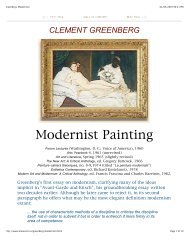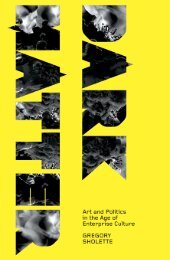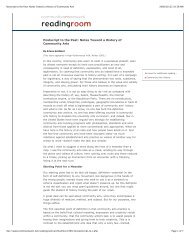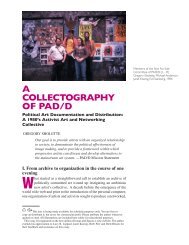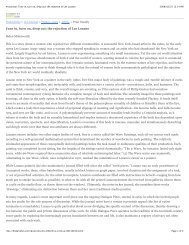The New Spirit of Capitalism - Dark Matter Archives
The New Spirit of Capitalism - Dark Matter Archives
The New Spirit of Capitalism - Dark Matter Archives
You also want an ePaper? Increase the reach of your titles
YUMPU automatically turns print PDFs into web optimized ePapers that Google loves.
As opposed to the type <strong>of</strong> job security that was on <strong>of</strong>fer during the 1960s, involving ameritocratic approach that was based on the achievement <strong>of</strong> negotiated targets, careers arenow viewed as a series <strong>of</strong> fulfilled projects. Job security is now predicated on the"employability" that a person develops as he or she gains experience.5
7ExcitementFairnessSecurityFreedom from localcommunities ProgressA mix <strong>of</strong> domestic andmarket fairnessPersonal property,Personal relationshipsCharity,PaternalismCareer opportunitiesPower positionsEffectiveness possiblein “freedomcountries”Meritocracy valuingeffectivenessManagement byobjectivesLong term planningCareersWelfare stateNo more authoritarianchiefsFuzzy organisationsInnovation andcreativityPermanent change<strong>New</strong> form <strong>of</strong>meritocracy valuingmobility, ability tonourish a network,…Each project is anopportunity to developone’s employabilityFor the mobile andthe adaptableCompanies willprovide self-helpresourcesTo manage oneself<strong>The</strong> transformations <strong>of</strong> the last decades have been accompanied by a relatively radicalchange in the definition <strong>of</strong> what comprises a fair work situation, and a fair treatment <strong>of</strong> someemployees as compared to others. <strong>The</strong> following section allows us to identify the nature <strong>of</strong>this change.3. <strong>The</strong> emergence <strong>of</strong> a new value systemTo be able to identify the exact nature <strong>of</strong> the notion <strong>of</strong> fairness as depicted in themanagement texts we studied, we used a theoretical construct that Luc Boltanski haddeveloped together with Laurent Thévenot in an earlier publication (Boltanski, Thévenot,1991): the “justificatory regime ”model (“Cité ” in the French). This construct had initiallybeen designed with a view towards highlighting the conditions that make it possible to saywhether an evaluation or distribution <strong>of</strong> goods was being done in a fair and legitimate manner.<strong>The</strong>se situations are characterised by the fact that whatever judgement peopleultimately make, they face a certain amount <strong>of</strong> criticism. Refusing to remain within theconfines <strong>of</strong> the opposition that is usually drawn between the sociology <strong>of</strong> consensus and thesociology <strong>of</strong> criticism, Boltanski and Thévenot argued that these “legitimate orders” can beused to reach agreement as well as to support criticism. <strong>The</strong>y called these constructs Cités,thus referring to classical political philosophies whose object had been to design a legitimateorder based on a principle <strong>of</strong> justice. However, as opposed to political philosophies that hadusually attempted to anchor this social order in a single principle (utopianism), they arguedthat, in complex modern societies, several justificatory regimes can coexist within the samesocial space, even though their relevance may vary in accordance with the situation’scharacteristics (i.e., with the material or symbolic nature <strong>of</strong> the objects involved). Finally,unlike the “linguistic turn”, and in order to avoid an idealistic construction that is overlyreliant on verbal argumentation, Boltanski and Thévenot considered that people’s claims hadto be confronted with the real world, hence pass a series <strong>of</strong> more or less standardisedprocedures they called tests (“épreuve” in the French). In the end, it is the outcome <strong>of</strong> these
9e) a format <strong>of</strong> investment, this being a major pre-condition for each Cité‘s stability since, bylinking greatness to sacrifice (which takes a specific form in each Cité), it ensures that allrights are <strong>of</strong>fset by responsibilities;f) a paradigmatic test which, for each justificatory regime, best reveals a person’s greatness;g) a harmonious figure <strong>of</strong> natural order, conveying the ideal-types that correspond to theuniverses within which there has been a fair distribution <strong>of</strong> the quality <strong>of</strong> greatness.We analysed the two bodies <strong>of</strong> work through the filter <strong>of</strong> this analytical grid. It seemsthat the six justificatory regimes identified by Boltanski and Thévenot (1991) cannot fullydescribe all <strong>of</strong> the types <strong>of</strong> justification that can be found in the 1990s texts that we havestudied. We think that a new and increasingly influential justificatory logic has cropped up,one that emphasises mobility, availability and the variety <strong>of</strong> one’s personal contacts. To stressits novelty and specificity, we have encoded this logic as a 7 th justificatory regime, a ProjectsorientedCité. This refers to a form <strong>of</strong> fairness that is appropriate in a world which isorganised by networks (still described as being connexionist and reticular in nature). Table 3<strong>of</strong>fers a brief look at the characteristics <strong>of</strong> this latest Cité.Table 3: <strong>The</strong> Grammar <strong>of</strong> the Project-Oriented Justificatory RegimeEquivalency Principle (General Standard): activity; project initiation; remote links between peopleA State <strong>of</strong> Smallness: inability to get involved, to trust in others, to communicate; close-mindedness,prejudice, authoritarianism, intolerance, stability, over-reliance on one’s roots, rigidity…A State <strong>of</strong> Greatness: adaptability, flexibility, polyvalence; sincerity in face to face encounters;ability to spread the benefits <strong>of</strong> social connections, to generate enthusiasm and to increaseteammates' employabilityDirectory <strong>of</strong> Subjects : managers, coaches, innovatorsDirectory <strong>of</strong> Objets : computer and information technologies. <strong>New</strong> organisational devices (subcontracting,flexibility, outsourcing, autonomous units, franchises…).Natural Relationship: trusting and being trustworthy; ability to communicate; adaptability to others’needsGreatness ratio: “great” persons enhance “small” persons’ employability in return for their trust andenthusiasm for project work (i.e., their ability to take part in another project).Format <strong>of</strong> Investment: ready to sacrifice all that could curtail one's availability, giving up lifelongplansStandard (Paradigmatic) Test: ability to move from one project to another.Harmonious Figure <strong>of</strong> Natural Order: where the world's natural form resembles that <strong>of</strong> a networkHypothesizing the emerging <strong>of</strong> a new Cité where the relevant tests deal with theestablishment <strong>of</strong> connection does not imply that forming networks is something drasticallynew, as some recent network studies seem to suggest. Our stand is different. Networks,however large, are not any newer than the market was when Adam Smith wrote Wealth <strong>of</strong>Nations. But, it seems that it was not until the last third <strong>of</strong> the 20 th century that mediating - theart <strong>of</strong> connecting and making use <strong>of</strong> the most diverse and furthest ties - became autonomous,set apart from other activities behind which it had until then been hidden, and was identifiedand valued in itself. This process, we believe, is what constitutes an important novelty.In the Project-oriented Cité the general standard, with respect to which all persons’and things’ greatness is evaluated, is activity. Contrary to what happens in the Industrial Cité- where activity means “work” and being active means “holding a steady and wage-earningposition” - in the Project-oriented Cité, activity overcomes the oppositions between work andno-work, steady and unsteady, paid and unpaid, pr<strong>of</strong>it-sharing and volunteer work, andbetween that which can be measured in terms <strong>of</strong> productivity and that which cannot beassessed in terms <strong>of</strong> accountable performances. Life is conceived as a series <strong>of</strong> projects, allthe more valuable when different from one another. What is relevant is to be always pursuing
10some sort <strong>of</strong> activity, never to be without a project, without ideas, to be always lookingforward to, and preparing for, something along with other persons, whose encounter is theresult <strong>of</strong> being always driven by the impulse <strong>of</strong> activity.When starting on a new project, all participants know that it will be short-lived, that itnot only may but surely will one day come to an end. <strong>The</strong> perspective <strong>of</strong> an unavoidable anddesirable end is encapsulated in the very involvement without curtailing the enthusiasm <strong>of</strong> theparticipants. Projects are well adapted to networking for the very reason that they aretransitory forms: the succession <strong>of</strong> projects by multiplying connections and increasing thenumber <strong>of</strong> ties results in an expansion <strong>of</strong> networks.In the Project-oriented Cité, a “great one” must be adaptable and flexible. He or she ispolyvalent, able to move from one activity, or the use <strong>of</strong> one tool, to another. A “great one” isalso active and autonomous. He or she will take risks, make contact with new people, open upnew possibilities, seek out useful sources <strong>of</strong> information, and, thus, avoid repetition.Still, these qualities by themselves cannot suffice to define the state <strong>of</strong> “being great”because they could also be implemented in an opportunistic way, to pursue a strictly selfishcourse towards success. By contrast, in our model, a “great” person will take advantage <strong>of</strong>his/her given qualities to contribute to the common good. In the Project-oriented Cité, a “greatone” therefore also generates a feeling <strong>of</strong> trust. He or she does not lead in an authoritarianway, as did the hierarchical chief. He or she manages his/her team by listening to others withtolerance and by respecting their differences. He or she redistributes between them theconnections he or she has secured when exploring networks. Such a project manager henceincreases all his/her teammates’ employability.As each justificatory regime is associated with a specific vocabulary, we used alexicographic s<strong>of</strong>tware to analyse the lists <strong>of</strong> names that are associated with each regime, andthen tried to found out which Cités cropped up most frequently in both bodies <strong>of</strong> work. <strong>The</strong>presence <strong>of</strong> a Cité is measured here as the number <strong>of</strong> times that the category which had beencreated to represent that justificatory regime appeared in a given body <strong>of</strong> work (cf. Table 4.)Table 4: <strong>The</strong> seven worlds’ presence in each <strong>of</strong> the bodies <strong>of</strong> work 41960s1990sIndustrial logic 6764Industrial logic 4972Domestic logic 2033Network logic 3996Market logic 1841Market logic 2207Civic logic 1216Domestic logic 1404Network logic 1114Inspirational logic 1366Inspirational logic 774Civic logic 793Renown logic 479Renown logic 768Our first observation, an unsurprising one given that the aim <strong>of</strong> both our two sampleswas to improve the organisation <strong>of</strong> work, is that the Industrial logic dominated during bothperiods - with references to this logic having been generally positive during the 1960s yet<strong>of</strong>ten critical during the 1990s. <strong>The</strong> predominance <strong>of</strong> an Industrial logic was clearcut duringthe 1960s, but much less so in the 1990s. Note the ratio between the number <strong>of</strong> times itoccurred in each sample, and the number <strong>of</strong> times each decade’s second-place logic occurs. Inthe 1990s, the Industrial logic’s relative importance is diminished by the many representatives4 <strong>The</strong> two bodies <strong>of</strong> work are more or less comprised <strong>of</strong> the same number <strong>of</strong> names in absolute terms.
11<strong>of</strong> the Projects-oriented Cité (a.k.a. a Network logic) – who were twice as numerous in the1990s as the second-place logic had been during the 1960s.<strong>The</strong> rising power <strong>of</strong> the second-place Network logic is definitely one <strong>of</strong> the majorchanges between our two eras. This means that with our theoretical construct <strong>of</strong> a ProjectsorientedCité, we have succeeded in crystallising at least some <strong>of</strong> the new discursive aspects<strong>of</strong> the management texts being studied. Other logics that have also increased their presenceinclude the Market logic - no surprise given the rise <strong>of</strong> a worldview which is based onincreased competition, and which makes room for corporate reorganisations aimed at ensuringthat all employees have a sense for the pressures and demands emanating from a firm'sclients. <strong>The</strong>re has also been a strengthening <strong>of</strong> the Inspirational logic, which should be seenin light <strong>of</strong> the emphasis that was placed during the 1990s on innovation, risk, the permanentsearch for new solutions, highly personalised qualities, etc. As for the Domestic and Civiclogics, they have lost ground, in much the same way that the Industrial logic has alsoweakened.Changes in France's capitalistic process between the 1960s and 1990s have beenaccompanied by a major re-ordering <strong>of</strong> the systems and values that are considered to berelevant and legitimate for the assessment <strong>of</strong> people, things and situations. More specifically,there have been changes in the mechanisms that are intended to ensure the fairness <strong>of</strong> work.Not only have firms altered the types <strong>of</strong> organisation they propose, but they have alsochanged behavioural norms, the definition <strong>of</strong> good and bad actions and the sources <strong>of</strong> theirjustification. Reformulated using the language <strong>of</strong> a Cité model, a transformation <strong>of</strong> the sortcan also be interpreted as a change in standard tests or in testing systems. This is becausethose concrete systems whose goal it is to inscribe the principles <strong>of</strong> fairness into the world arenone other than tests themselves.4. Proposition <strong>of</strong> a theoretical framework for analysing the way in which norms change4.1. Tests <strong>of</strong> strength and legitimate testsWe make a distinction between two different test modes: tests <strong>of</strong> strength (épreuves deforce); and legitimate tests (épreuves légitimes).Of course, a test is always a test <strong>of</strong> strength. Yet a test can be considered to belegitimate as long as strengths are being measured according to the tenets <strong>of</strong> the particularCité model within which it falls. An overriding requirement is the obligation to specify thetype <strong>of</strong> strength that is involved in a specific test and to arrange a testing device that does notcall upon the use <strong>of</strong> any other kind <strong>of</strong> strength. All in all, a legitimate test must always testsomething that has been defined, presenting itself as a test <strong>of</strong> something: for example, a test <strong>of</strong>industrial efficiency, market opportunism, respect for domestic duties, or even (the schoolsystem <strong>of</strong>fers many examples) Latin or sociology. If a test is to be legitimate, the strengthsupon which it focuses must undergo a process <strong>of</strong> qualification and categorisation.By contrast with a legitimate test, it is acceptable in a test <strong>of</strong> strength to mobilise anyand all kinds <strong>of</strong> strength. Nothing is specified beforehand. Anything goes, as long as it iscrowned with success. In a legitimate test, on the other hand, everything is not possible.If a legitimate test relates to the work world, it may ultimately end up adding to theconstraints that impede the process <strong>of</strong> capitalist accumulation. In other words, the spirit <strong>of</strong>capitalism, ins<strong>of</strong>ar as one <strong>of</strong> its components is an awareness <strong>of</strong> fairness, acts as a constraint on
12the economic process. Indeed, it is because <strong>of</strong> the existence <strong>of</strong> this constraint that the processis legitimised. We could even say that the price to pay, if people are to consider corporateactivities (and the organisational models they inspire) to be legitimate, is the implementation<strong>of</strong> testing systems that act as a constraint upon firms’ general management.We are going to take one example <strong>of</strong> the way in which the accumulation can beconstrained by references to that which is being required <strong>of</strong> a firm (expressed in terms <strong>of</strong> thecommon good, i.e., using the vocabulary <strong>of</strong> the present article, in terms <strong>of</strong> the justificatoryregime). In a Market Cité, the validity <strong>of</strong> pr<strong>of</strong>its (and <strong>of</strong> the societal order that results from theconfrontation between the many different people who are also seeking a pr<strong>of</strong>it) dependsentirely on whether the market test fully satisfies constraints such as the equality <strong>of</strong> chances -so that success can be fully attributed to merit alone (in the present example, to the ability toseize the opportunities that the market <strong>of</strong>fers, and/or to the attractiveness <strong>of</strong> the goods andservices on <strong>of</strong>fer) rather than to any pre-existing balance <strong>of</strong> power. Amongst these constraints,note first and foremost the assurance that any given situation will be a competitive one(marked by an absence <strong>of</strong> dominant positions, previous agreements, cartels), and thatinformation will be transparent. As such, it is only under certain extremely restrictiveconditions that a market test can be said to be legitimate. Moreover, the fulfilment <strong>of</strong> all <strong>of</strong>these conditions fails to provide, in and <strong>of</strong> itself, any specific contribution to the creation <strong>of</strong>pr<strong>of</strong>it. Quite the contrary – it can be a serious handicap.At a broader level, in a society where much testing is subjected to the same constraintsas those that feature in our definition <strong>of</strong> a “legitimate test”, the strength <strong>of</strong> society’s strongermembers is diminished. This is because the ways in which the tests are formulated (attemptsto make them “fairer”) tend to restrict opportunities for people who possess a diversified yetpoorly defined set <strong>of</strong> strengths – forces that tend to be displaced, confused, exchanged andextended for no other reason than the strategic necessities <strong>of</strong> a given situation. You cannotpay a literary critic so that s/he will recognise you as a great and inspired author; you do notbecome a chief <strong>of</strong> staff simply because you are the minister’s cousin, etc. Victory by anymeans is not possible.And yet, tests <strong>of</strong> strength and legitimate tests should not be construed as standaloneentities that exist in opposition to one another. <strong>The</strong>re is a continuum between the two, leadingto a situation in which tests are seen as being more or less fair. Moreover, we can always findout how it is that an action which stems from a test’s underlying strengths detracts from itsavowed legitimacy. One example is the way in which the handicap <strong>of</strong> a child’s socioeconomicsituation is recognised nowadays as something that affects scholastic performances – withoutexaminers having done anything explicit about it.Each <strong>of</strong> these two types <strong>of</strong> tests (the test <strong>of</strong> strength and the legitimate test)corresponds to a specific mode <strong>of</strong> action. We call the first a “mode <strong>of</strong> categorisation” becausean individual’s actions are publicly judged by other people. Here, the judgement is basedupon certain explicit and acknowledged principles <strong>of</strong> equivalency, many <strong>of</strong> which are legallyenforced. As a result, this mode refers to social conventions that are imbued with a broadbasedvalidity as well as with a certain type <strong>of</strong> externality (i.e., a form <strong>of</strong> transcendence).Consequently, such conventions can be envisaged independently <strong>of</strong> the situations in whichthey are acted out.<strong>The</strong> second we call a “displacement mode”. This is because the orientation <strong>of</strong> theactions and the forces which it infers change depending on local circumstances and/or the
13degree <strong>of</strong> resistance they encounter. In this instance, the test is a test <strong>of</strong> strength. This is amode that does not require anyone to make a judgement. Contrary to the categorisation mode,it does not refer to social conventions, and assumes neither externality nor generality. Assuch, displacement is always local, eventful, and circumstantial. It can easily be mistaken forrandomness and is satisfied with a limited amount <strong>of</strong> reflexivity. Displacement can bedescribed with reference to one plane only (that which Gilles Deleuze calls the “plane <strong>of</strong>imminence”). It thus avoids any justificatory constraint, one that would have inferred thenecessity <strong>of</strong> referring to a second plane – precisely the same level that, within a logic <strong>of</strong>categorisation, serves as an embodiment <strong>of</strong> the equivalency convention.Broadly speaking, changes in test systems seem to involve groups <strong>of</strong> actors trying t<strong>of</strong>ree themselves from that which keeps them from enjoying and from increasing theirprivileges. <strong>The</strong>y do this by looking for new ways to succeed and to gain recognition withouthaving to take currently legitimate tests. Such actors tend to avoid established tests byexperimenting with hazardous, local and <strong>of</strong>ten low-key displacements.When they are successful, these displacements gradually modify the test system. <strong>The</strong>ysubstitute new, less formalised, and less acknowledged tests for previous ones that (being wellestablished, prominent, and <strong>of</strong>ten constrained by legal regulations) have been increasinglysubject to criticism. In a given society, these displacements increase the relative importance <strong>of</strong>tests <strong>of</strong> strength with respect to legitimate relationships based on institutionalised tests.Yet new legitimate tests may emerge if at least one <strong>of</strong> the following two conditions isfulfilled.1. If the people who have enacted these displacements think that they have strengthened theirposition and feel that they are entitled to specific acknowledgement, they may claim tohave contributed, each in his/her own way, to the common good.2. When the displacements that these people have carried out (shifts that others hadheret<strong>of</strong>ore deemed to be individual, circumstantial or marginal in nature) start to be seenas something that is generally effective. <strong>The</strong>se behaviours will then be subjected tocriticisms that will equate these new devices (stemming as they do from previousdisplacements) to new tests that have not yet been identified or categorised.Actors to whom such displacements have been beneficial can then develop, both forthemselves and for others, a value (a “greatness”) that will convey their hold on the world.Moreover, by so doing, they can inject an autonomous moral dimension into their situation.<strong>The</strong>y turn these new tests into something that is justifiable.Along with this legitimisation process, norms are established (quite <strong>of</strong>ten through legalrules) so as to differentiate between morally acceptable and morally unacceptable and abusive(i.e. selfish) ways <strong>of</strong> making use <strong>of</strong> new resources 5 .5 In this perspective, a Cité appears as a self-referenced critical device that is part <strong>of</strong> (imminent to) aworld which in the process <strong>of</strong> being built and which needs to set up bounds for itself if it is to last. In Le NouvelEsprit du <strong>Capitalism</strong>e we argued that capitalism’s transformation over the past three decades has made itpossible both for a world that we call “connectionist” (i.e., self-described, using the network metaphor) tounfold, and also for an increase in the number <strong>of</strong> people who are justified in becoming mediators. Here we arearguing that the creation <strong>of</strong> a Project-oriented Cité is intended to legitimise the connectionist world and restrictits practices in such a way as to substantiate the affirmation <strong>of</strong> a justificatory constraint that acts on behalf <strong>of</strong> thecommon good.
15remain legitimate, they must incorporate a response to this criticism. This can either consist<strong>of</strong> showing how the criticism is wrong (in which case convincing evidence must be provided)or else it can involve tightening up the test’s control, cleaning it up in such a way as to ensurethat it is more in line with the underlying fairness model. This is what happens, for example,when following a series <strong>of</strong> criticisms an examination that had originally borne the names <strong>of</strong>the people being tested becomes an anonymous one.However, there is another possible reaction to the corrective criticism <strong>of</strong> a test. Thisconsists <strong>of</strong> trying to circumvent this criticism instead <strong>of</strong> answering it. It may be in the interest<strong>of</strong> a certain number <strong>of</strong> actors for the test to lose some <strong>of</strong> its importance, i.e., for it to becomerelatively marginalised, especially if it becomes too difficult to answer criticisms that areconstantly being renewed and which therefore force the test organiser to tighten it up andincrease its total cost. In lieu <strong>of</strong> a direct criticism <strong>of</strong> these institutionalised tests, a propositionthat would be too expensive (above all in terms <strong>of</strong> legitimacy), they end <strong>of</strong> having to look forsources <strong>of</strong> pr<strong>of</strong>its that are new and based on displacements which are local, <strong>of</strong> littlesignificance, not very visible and multitudinous.<strong>The</strong>se displacements can be geographic in nature (delocalisation towards regionswhere workers are inexpensive and where labour law is underdeveloped and/or rarelyrespected). One example would be where companies decide that they do not want to improvethe breakdown <strong>of</strong> revenues between wages and pr<strong>of</strong>its, if this is what critics are demanding.Environmental legislation provides an analogous situation. Another example would be afirm’s modification <strong>of</strong> its career-related criteria for success after it has decided either tocircumvent its customary career management procedures or else to eliminate formal(graphological, psycho-technical etc.) testing during its recruitment process - actions that are<strong>of</strong>ten seen as being too expensive.Another consequence <strong>of</strong> this new type <strong>of</strong> reaction to criticism, involving the use <strong>of</strong>displacement, is that it temporarily disarms criticisms by presenting critics with a world thatthey no longer know how to interpret. <strong>The</strong> criticisms and systems <strong>of</strong> criticism that areassociated with a previous spirit <strong>of</strong> capitalism are barely relevant to new forms <strong>of</strong> testing thathave not yet been subjected to any attempts at recognition, institutionalisation, codification orcategorisation. This is because one <strong>of</strong> the primary tasks <strong>of</strong> criticism is in fact to identify themain tests <strong>of</strong> a given society, and to clarify and/or incite protagonists to clarify the principlesunderlying these tests so that it is subsequently possible to carry out a corrective or radical(reformist or revolutionary) criticism - depending on which options are available at the time,and on the strategies <strong>of</strong> the persons who are involved.Criticism can thus impact testing in several ways.1) It is the role <strong>of</strong> criticism to identify those tests that are truly important to a society byexposing its "tests <strong>of</strong> strength" in broad daylight. Here criticism proceeds bycategorisation, that is, by organising a series <strong>of</strong> individual situations that are shown (bythe criticism) to have something in common – in this instance, the fact that they determinepeople’s position in society, and thus their comparative social value.2) Criticism <strong>of</strong> the tests’ format can purify the tests (tighten them up) in terms <strong>of</strong> the fairnessthat they embody. <strong>The</strong> purpose is to ensure that strengths that should not feature in the testare not in fact a part there<strong>of</strong> - or else to promote the implementation <strong>of</strong> procedures andregulations that make the test fairer.
163) Criticism is responsible for continually keeping an eye on a society's central tests,ensuring that legitimate tests respect the agreed format (and that variances from thisformat are denounced).4) Inversely, criticism can try to get certain tests eliminated in the name <strong>of</strong> the general desireto see changes in the currently prevailing system <strong>of</strong> values. In this instance, criticismhelps to delegitimise the tests, not from inside the system (as is the case with the strongmembers <strong>of</strong> a society, those who have succeeded at the tests without having had to paytheir real cost) but from the outside. <strong>The</strong> idea here is that it is unacceptable forevaluations and selections to be made on the basis <strong>of</strong> certain principles that should in factbe abolished.5. Applying the model to changes in France between 1968 and 1995Since the spirit <strong>of</strong> capitalism that prevails during a particular era contribute, to thebuilding <strong>of</strong> a legitimate test that can be used in capitalist work situations, the aforementionedcriticisms are actually aimed at the capitalist system itself.Criticism <strong>of</strong> capitalism is as old as capitalism itself. <strong>Capitalism</strong> is in need <strong>of</strong>justification for the very reason that it is criticised. Where there is no criticism, there is noneed for justification (and then for something like a spirit <strong>of</strong> capitalism). We have thereforedistinguished between the two types <strong>of</strong> criticisms that have developed since the 19 th century.We label the first “social criticism”. Here the emphasis is on inequalities, misery,exploitation, and the selfishness <strong>of</strong> a world that stimulates individualism rather than solidarity.Its main vector has been the labour movement.We label the second form <strong>of</strong> criticism (which Chiapello (1998) studied in her previousbook, Artistes Versus Managers, derived from Grana’s book Bohemian versus Bourgeois)“artistic criticism”. This form first emerged in small artistic and intellectual circles, andstresses other characteristics <strong>of</strong> capitalism. In a capitalist world, it criticises oppression(market domination, factory discipline), the massification <strong>of</strong> society, standardisation andpervasive commodification. It vindicates an ideal <strong>of</strong> liberation and/or <strong>of</strong> individual autonomy,singularity and authenticity.What underpins the transformation that took place between the second spirit <strong>of</strong>capitalism (still found to a large extent in our sample <strong>of</strong> 1960s management literature) and thethird spirit (illustrated by our 1990s management literature)? We have tried to explain thismovement without relying entirely on devices that are determined mechanically (andtherefore, to a certain extent, fatalistically), as is <strong>of</strong>ten the case when the entire emphasis isbeing placed on globalisation, market development, and technological transformations. Ouraccount is drawn from French examples. Yet we believe that it can be more broadly validated,albeit with specifications that take into account the particularities <strong>of</strong> the different Westernsocieties.Here, summarised in a very brief form, are the various stages <strong>of</strong> this transformation.a) >From 1965 to 1975, there was a very significant increase in the criticism <strong>of</strong> capitalism.1968 was the absolute peak, but this high point lasted for a period <strong>of</strong> several years. This
19<strong>The</strong> new capitalist deployment was greatly facilitated by critics’ silence during thisperiod <strong>of</strong> time. And to a large extent, this silence was the product <strong>of</strong> preceding displacements,on two levels at least.Social criticism, usually voiced by the principal labour unions, was disarmed by aform <strong>of</strong> change it could not interpret. It had been built in an isomorphic relationship to itsopponent, the large integrated firm. It therefore lost its ability, in the new process, to exertpressure on employers' decisions.Artistic criticism, on the other hand, lost its edge for a very different reason. Many <strong>of</strong>those who had been voicing this form <strong>of</strong> criticism at the time <strong>of</strong> the 1968 crisis had becomesatisfied with the changes that had taken place in the organisation <strong>of</strong> work and, more broadly,in society. <strong>The</strong> incorporation <strong>of</strong> many components <strong>of</strong> artistic criticism into the new spirit <strong>of</strong>capitalism had deprived earlier critics <strong>of</strong> reasons for feeling discontented – and rendered theminsensitive to the superficiality <strong>of</strong> the achievements <strong>of</strong> the so-called liberation movement.Moreover, in the Socialist era that has been France’s hallmark since 1981, many supporters <strong>of</strong>artistic criticism have been co-opted into the power elite.<strong>Capitalism</strong>’s renewed growth during the 1980s was largely due to its ability toovercome the constraints that were a part <strong>of</strong> the second spirit <strong>of</strong> capitalism, and render themobsolete. Changes in the nature <strong>of</strong> tests, and silence from disorientated critics, enabledcapitalism to spread once again, freeing it from most <strong>of</strong> the constraints that it had previouslyhad to face. One outcome <strong>of</strong> this process was that the wage/pr<strong>of</strong>it ratio again began to benefitcapital. <strong>The</strong> cost was rising inequality, precarious working conditions, and theimpoverishment <strong>of</strong> many wage earners.Worsening conditions for a great many individuals brought criticism back to life in the1990s – as shown by the wave <strong>of</strong> strikes that hit in late 1995. Criticism’s current renewal ismostly apparent in the field <strong>of</strong> social criticism, with artistic criticism remaining silent orbecoming standardised (hence inefficient). This renewal <strong>of</strong> social criticism raises the question<strong>of</strong> how new tests can be tamed and rooted in new regulations - one <strong>of</strong> the main concerns beingthe way in which flexibility can be structured. It is possible that the aim <strong>of</strong> many <strong>of</strong> themeasures that are currently being explored in France is to embed the Project-oriented Cité indevices that are stable in nature. One example is the “activity contract” (“contrat d’activité”)which, when combined with an employment contract, allows workers that a firm cannot ordoes not want to keep to seek further training or employment with a non-pr<strong>of</strong>it organisation.Of course, this is the history <strong>of</strong> France, a country characterised by almostuninterrupted Socialist rule since 1981, and therefore a society that has handed power over tothose who in 1968 had been demonstrating in the streets under the banner <strong>of</strong> artistic criticism.<strong>The</strong> history <strong>of</strong> Great Britain is a very different one, having been marked by the Thatcherrevolution. Indications are that different organisational models and spirits <strong>of</strong> capitalism willultimately prevail in each <strong>of</strong> these two countries: that they will be more market-oriented inGreat Britain (in the sense that our justificatory regime analysis lends to this term); and more“connectionist” in France.Conclusion
21Appendix 1Exemplifying several comments with the 1990s body <strong>of</strong> work<strong>The</strong> problems that have been identified<strong>The</strong> 1990s authors’ rejection <strong>of</strong> hierarchy is especially noteworthy given that theirreaders are essentially comprised <strong>of</strong> managers from large corporations – pr<strong>of</strong>essionals whodespite all <strong>of</strong> their efforts will find it difficult to avoid working within the strictures <strong>of</strong> ahierarchical framework. <strong>The</strong> explanations that are used to highlight this anti-hierarchical biasare <strong>of</strong>ten moral in nature, and should be analysed as part <strong>of</strong> a more widespread rejection <strong>of</strong>domination-driven relationships (see Extract 1). <strong>The</strong>y are also scrutinised in light <strong>of</strong> anotherirresistible societal trend – which is that people not only do not want to take orders anymore,but they do not even want to give them (2). For other authors, a general raising in thestandard <strong>of</strong> education explains why hierarchy has become an outdated organisational model(3). And whilst hierarchy is a favourite target for many critics, others also attack planning(denounced for its excessive rigidity) as well as all <strong>of</strong> the categories that are generallyassociated with the wielding <strong>of</strong> authority (bosses, chiefs, superiors, orders, etc.)Competition was another recurring theme during the 1990s – as was the unending andincreasingly rapid change in technology (already a subject <strong>of</strong> discussion during the 1960s).This latter topic reached unprecedented levels, with the vast majority <strong>of</strong> texts giving advice onhow to set up the sort <strong>of</strong> flexible and inventive organisation that is able to "surf" all "waves",i.e. adapt to all transformations. In the 1960s, the main goal was the loosening <strong>of</strong> bureaucraticrestraints, and observers at the time kept well away from aiming their criticism at thefundamental principles <strong>of</strong> organisation (i.e. Fayol's <strong>of</strong>ten used concept <strong>of</strong> unique reportingline etc.). In the 1990s, however, with the subversion <strong>of</strong> the hierarchical principle, there wassomething <strong>of</strong> a "big bang" – an expression coined by Peter Drucker, the seasoned guru, whoafter having been a particularly influential proponent <strong>of</strong> management by objectives during the1960s now foresaw the existence <strong>of</strong> "upside down" organisations. Another major figure inmanagement literature, Rosabeth Moss Kanter, has also explained that there will necessarilybe a time in the future "when the giants learn to dance" – this having been the title <strong>of</strong> her bestseller(Moss Kanter, 1992).Extracts:1. <strong>The</strong> organisational and the pyramidal hierarchies (...) indicate who knows how to manage, who is able tomanage and who has to be the one who is going to manage – as opposed to those who don’t know how tomanage or who are incapable <strong>of</strong> doing so. Even with the best will in the world, the only kind <strong>of</strong>interpersonal relationship that can occur in conditions such as these is the sort <strong>of</strong> relationship that existsbetween a person who expresses scorn and a person who is a target <strong>of</strong> scorn. This is because "those who donot know how to manage and/or are incapable <strong>of</strong> doing so" find themselves from the very beginning in aposition <strong>of</strong> de facto inferiority - as if they have been turned into children.... (Aktouf, 1989).2. Along with increased individualism, the irresistible move towards freedom <strong>of</strong> choice in all areas hasgenerated greater demands, and opportunities, for personal autonomy. <strong>The</strong> era <strong>of</strong> staff sergeants is over.Not only do subordinates no longer accept authority, but hierarchical superiors are themselves less and lesscapable <strong>of</strong> wielding it - even though more and more discipline is needed to respond to the demands <strong>of</strong> acomplex environmental (Crozier, 1989).3. Given that modern organisations are comprised <strong>of</strong> "erudite" specialists, they have to be an associationbetween equals, colleagues, associates... No particular type <strong>of</strong> knowledge dominates Everyone is judgedaccording to his/her contribution to the common good - and not in light <strong>of</strong> the allegedly inherent superiority
22<strong>of</strong> the function that s/he fulfils. <strong>The</strong> result is that a modern organisation cannot be an association <strong>of</strong> bossesand subordinates - it has to be an organised team. (Drucker, 1993) 6 .<strong>The</strong> solutions<strong>The</strong> systems that the 1990s authors have <strong>of</strong>fered for coping with the issues that theyhave identified form a vast potpourri <strong>of</strong> managerial innovations. Nevertheless, we can try toorganise these ideas around a few key ideas: lean companies that work in networks involvinga wide range <strong>of</strong> actors; team-based or project-oriented work organisation, geared towardscustomer satisfaction; and workers’ overall enthusiasm thanks to the vision <strong>of</strong> their leaders.Lean, "light" and "fat-free" firms have got rid <strong>of</strong> most <strong>of</strong> their hierarchical echelons.<strong>The</strong>y only maintain between three and five levels, and have fired entire hierarchical strata.<strong>The</strong>y have also separated from a large number <strong>of</strong> functions and tasks, and subcontracteverything that is not part <strong>of</strong> their core business, sometimes to former employees turnedentrepreneurs (N.T.: in a process called essaimage in the French, literally the workings <strong>of</strong> abeehive). Firms’investments are increasingly made in collaboration with other companies via"alliances" and "joint ventures" - and the stereotype <strong>of</strong> the modern company has become that<strong>of</strong> a slim-lined core which is surrounded by a potpourri <strong>of</strong> suppliers, subcontractors, serviceproviders, temporary personnel (this allows staff numbers to adjust to levels <strong>of</strong> activity),friendly firms, etc. Such constellations are said to be working in "networks".We are told that the workers themselves must be organised into smallmultidisciplinary teams (deemed to be more competent, flexible, inventive and autonomousthan the specialised departments which had been the hallmark <strong>of</strong> the 1960s); that the real boss<strong>of</strong> these teams is the customer; and that the person who is actually running them is more <strong>of</strong> aco-ordinator than a chief (cf. Extract 4). Moreover, such teams are not solely comprised <strong>of</strong> afirm's permanent staff members. <strong>The</strong>y can also include suppliers, customers, consultants andoutside experts. Plus the members <strong>of</strong> the team do not all necessarily have to work in closephysical proximity to one another - improvements in telecommunications having made itpossible to collaborate from remote locations. Once again, this is said to be an example <strong>of</strong>working in a "network". <strong>The</strong> company’s borders blur or fade away, and the organisation itselfseems to be made <strong>of</strong> little more than an accumulation <strong>of</strong> more or less durable contractualrelationships. Teams become a forum for self-organisation and self-control.<strong>The</strong>se new systems have lead to the weakening <strong>of</strong> the hierarchical principle.Organisations have become flexible, innovative and highly competent. Network organisationshave made it possible to get rid <strong>of</strong> costly hierarchies - structures whose only purpose had beento serve as a "relay" for senior management, and which had therefore provided no "addedvalue" for the customer.Extracts:4. Process teams, whether comprised <strong>of</strong> one or several individuals, don’t need bosses. Instead, they needcoaches (...) Traditional bosses define and distribute the workload. Now teams take care <strong>of</strong> this themselves.Traditional bosses supervise, oversee, control and verify the workflow as it progresses from one workstationto the next. Now teams take care <strong>of</strong> this themselves. <strong>The</strong>re is little room for traditional bosses in areconfigured environment. (Hammer, Champy, 1993).6 N.T. : Some <strong>of</strong> the extracts cited have been translated back into English from their French translation. <strong>The</strong>wording may therefore differ slightly from the original text, and as such these extracts should be considered as aparaphrasing rather than as a quotation.
23Remains the thorny problem <strong>of</strong> how a firm's overall direction is to be managed - anissue with which the authors in our sample are still grappling. <strong>The</strong> existence <strong>of</strong> networks doesnot mean that firms no longer exist as separate entities (i.e., that they have been diluted by thenetwork(s) within which they work). A firm’s senior managers will still devise thecompetition strategies that allow it to do battle with other multinationals (on those marketswhere they do not collaborate). Moreover, the self-organised and creative individuals whoare henceforth responsible for a firm's performance still need to be directed. This directionwill be the work <strong>of</strong> few persons – managers who in any event should be distinguished fromearlier, "hierarchical chiefs" Now we have leaders with vision (c.f., Extracts 5,6). Thanks toa shared sense-making in which all participate (the aforementioned "vision"), everyone knowswhat s/he has to do without being ordered to do so. A strong management direction is clearlyfelt without there being any need to issue orders, and personnel can continue to be selforganising.<strong>The</strong> 1990s authors write in terms <strong>of</strong> "managers" as opposed to "cadres", highlightingthose human qualities that have adapted best to capitalism's current requirements, and to theenvironment <strong>of</strong> "uncertainty" and "complexity" that firms have been plunged into. Managersare neither seeking to command, nor to order people around - and employees are not waitingfor orders before acting. Everyone has understood that such roles are out <strong>of</strong> date. Managershave become "team leaders", "catalysts", "visionaries", "coaches", and "drivers". <strong>The</strong> "driver"(N.T., "donneur de souffle"in the French, literally “the person who provides the breath”) is acharacter that was invented by Hervé Sérieyx. Like other 1990s authors who lacked theappropriate vocabulary to describe the new corporate hero, Sérieyx was forced to make up hisown expressions. Rosabeth Moss Kanter talks about "corporate athletes", Meryem Le Sagetabout "intuitive managers" and Lionel Bellenger about "pros" (7). Other terms such as coach,team leader or "midwife" are used by several different authors.Extracts:5. Vision, a commodity that creates enthusiasm, is not just a mission - it is also a powerful magnet. Like allgreat challenges, vision awakens collective capacities. (Crozier, Sérieyx, eds., 1994).6. <strong>The</strong> leader is a person who has been given this role by the group - the person with whom each individual inthe group consciously or subconsciously identifies. Thanks to his/her influence, visionary artistry andorientations, the leader creates a current that spurs people into transcending themselves; into trusting others;and into showing initiative (Cruellas, 1993).7. We don't even possess an appropriate vocabulary for discussing these new types <strong>of</strong> relationships. <strong>The</strong> terms"superiors" and "subordinates" hardly seem precise enough. Even words like "boss" and "employees" implyconcepts <strong>of</strong> control and/or rights which managers do not always actually have. (Moss Kanter, 1991)With the decline in nearby hierarchical control, there have been increasing referencesin management (and indeed in micro-economic) literature to the idea <strong>of</strong> trust. Trust is thatwhich unites team members amongst themselves; a firm with its leader; a coach with theperson s/he is helping; or partners within an alliance. Trust presupposes self-control – itfocuses on the existence <strong>of</strong> secure relationships in situations that are otherwise based onnothing more concrete than words and/or moral contracts. Indeed, trust possesses a moraldimension, whereas control by a third party is little more than the expression <strong>of</strong> a relationshipthat is based on the domination <strong>of</strong> one party by another (8).Extract:8. <strong>The</strong> balance <strong>of</strong> power is no longer a salient issue when the main objective is the creation <strong>of</strong> a sense <strong>of</strong>belonging, a feeling <strong>of</strong> satisfaction with and trust in one another (Aktouf, 1989).
25bureaucracy. This was very different from that which had been observed during the precedingera.<strong>The</strong> most pugnacious author on this topic has turned out to be Bob Aubrey, who likesto remind his readers that Maslow’s pyramid is a false scientific law (11). Notwithstandingthis allegation, management authors also know that few people will feel attracted by theirproposals if they don’t <strong>of</strong>fer any new forms <strong>of</strong> security. <strong>The</strong>y are aware <strong>of</strong> the need to proposesomething that can replace the hierarchical careers that had been such an integral part <strong>of</strong> thesecond spirit <strong>of</strong> capitalism. One suggestion has been that this format should be replaced by theidea <strong>of</strong> a succession <strong>of</strong> projects. In this conception, people no longer develop careers, ratherthey move from one project to another, with their success on a given project being that whichenables them to accede to another, more interesting one. Each project is an opportunity tomake many new acquaintances, and it therefore <strong>of</strong>fers people the chance to earn a solidreputation and to be co-opted into a new activity. Moreover, given that each project, bydefinition, is different, new and innovative in nature, it can be presented as an opportunity forlearning and for adding to one’s own competencies – this being an advantage in finding otherengagements (12) (13).<strong>The</strong> key concept in this view <strong>of</strong> working life is employability. This notion is supposedto describe the ability that people must possess if they want to be asked to participate in agiven project. <strong>The</strong> transition from one project to another is an opportunity to enhance one’semployability. This is a personal capital that each individual has to manage in his/her ownway. It is the sum total <strong>of</strong> a person’s usable competencies. A firm will be seen as <strong>of</strong>fering acertain form <strong>of</strong> security when it develops rather than destroys its employees’ employability atthose times that it is unable to avoid either dismissing people or else when it cannot <strong>of</strong>ferthem a promotion (14). As such, the 1990s authors do <strong>of</strong>fer several solutions for job securityrelatedproblems, even though their proposals lack an instrumentation that is comparable tothat which had been on <strong>of</strong>fer in 1960s writings on managing executive workforces - literaturethat had provided many details on the best ways to recruit and evaluate people, or on how tohelp them to develop. In the texts we read, there were hardly any systems for assessingemployability, for verifying whether it is on the rise or else deteriorating, etc. One optimisticexplanation for this would be that the texts from the 1960s involve a relatively lateformulation <strong>of</strong> the second spirit <strong>of</strong> capitalism. This was an era during which the then currentspirit had already been in place for quite some time. <strong>The</strong> 1990s texts on the other hand areassociated with a brand new spirit <strong>of</strong> capitalism, one that is just emerging, and which has notyet reached the height <strong>of</strong> its motivational powers.Extracts:11. Organisations nowadays have to assimilate a new reality, and treat each employee as if s/he were a firm.This change means that some <strong>of</strong> the suppositions that had dominated industrial society have to beabandoned, first and foremost the idea that people are looking for job security. This is a 1950s concept bornout <strong>of</strong> Abraham Maslow’s famous “pyramid <strong>of</strong> needs”, with its postulate that fundamental needs must besatisfied before we can even begin to consider other types <strong>of</strong> fulfilment. Now, not only is this thesisproblematic from a theoretical perspective (how does it explain the fact that some people risk their[material] security to become artists or to start a new career?), but there is little justification for the way inwhich it has been interpreted in management circles (i.e., the firm’s first responsibility is to create a secureenvironment, with fulfilment only coming at a later stage). (Aubrey, 1994).12. <strong>The</strong> post-industrial career is an unending sprint from one project to the next. <strong>The</strong> measure <strong>of</strong> success <strong>of</strong> agiven project is the value that it adds (...) Each person depends much more on his/her own resources ratherthat on the destiny <strong>of</strong> whatever company happens to be the titular employer at the time. Those who are notconversant in the art <strong>of</strong> climbing the hierarchical ladder tend to fall by the wayside (...) Everyone has to
26create a personal portfolio <strong>of</strong> aptitudes, as firms no longer guarantee job security. And there is every chancethat entire populations will learn new competencies during this process. (Moss Kanter, 1992)13. If the organisation <strong>of</strong> the future only features a few hierarchical levels (i.e., three or four instead <strong>of</strong> a dozen),there will be fewer echelons that candidates will have to succeed at before reaching a relatively seniorposition. Career development will entail more lateral and less vertical movement. With people acceptingnew areas <strong>of</strong> activity or other types <strong>of</strong> responsibilities, the focus will be more on learning and on broadeningone’s own experience than on acceding to a higher rank. In addition, this type <strong>of</strong> development will notautomatically lead to increased remuneration. <strong>The</strong> times have changed, and so have the rules <strong>of</strong> the game.<strong>The</strong> career paths that people will be following are no longer clearly signposted. As a result, successfulcareer management in this brave new world infers the people become actors in their own development,taking charge <strong>of</strong> their own future. No one else is going to be doing it for them. (Le Saget, 1994)14. Job security cannot be guaranteed. On the other hand, firms can guarantee “employability”, that is, a level <strong>of</strong>competency and flexibility that will enable each individual to find a new job within his/her firm – or outside<strong>of</strong> it (Aubrey, 1993).
27Appendix 2Articles and books which have provided the extracts<strong>of</strong> the 1990s body <strong>of</strong> workTexts which original language is FrenchArticlesADAM Edmond, 1993, "Le coaching ou le retour vers la personne", Management France, n° 86 ,Nov, pp. 12-14ARPIN Roland, 1994, “ Diriger sans s'excuser ”, Revue internationale de gestion, vol. 19, mai, n°2,pp. 55-61AUBREY Bob, 1993, "Repensons le travail du cadre", Harvard-l'Expansion, Août, pp.56-64AUBREY Bob, 1994, “ La métamorphose du travail conduit à l'entreprise de soi ”, (présentation deson livre "Le travail après la crise"), Management France, Fev, n° 87 pp. 22-23BARON Xavier, 1993, "Les enjeux de gestion des salariés travaillant dans les structures par projets",Gestion 2000, n°2, pp. 201-213DESCLÉE DE MAREDSOUS Xavier, 1992, “ L'exercice du leadership ou la gestion de sa carrière aujour le jour ”, Gestion 2000, vol. 7 numéro spécial: "gérer votre carrière", pp. 105-126GASTALDI Dino, 1990, “ Le métier de cadre : évolution et prise en compte du management ”,Direction et Gestion, n° 126-127, pp.57-62GIRARD Bernard, 1994, “ Vers un nouveau pacte social ”, Revue française de gestion, n° 100, sept,pp.78-88LEMAIRE Bruno, 1994, “ Des entreprises sans hiérarchie? ”, L'Expansion Management Review ,automne, pp.74-82,MIDLER Christophe, 1993, “ La révolution de la twingo ”, Gérer et comprendre, Juin, pp. 28-36 MaiMORIN Pierre, 1994, “ La fin du management romantique ”, Management France, n°88, pp 14-17,RAUX Jean-François, 1994, “ Management et mutations ”, Futuribles, n°187, Mai, pp. 9-26SERIEYX Hervé, 1993, “ A propos du big bang des organisations ”, Management France, n°85, pp29-30STREBEL Paul, 1994, “ Comment faire évoluer les règles du jeu ”, L'Expansion Management Review,Eté, pp 17-21WEISS Dimitri,1994, “Nouvelles formes d'entreprise et relations de travail ”, Revue Française deGestion, n°98, Mars-Avril-Mai, pp. 95-103BooksAKTOUF Omar, 1989, Le management, entre tradition et renouvellement, Montréal, Gaëtan MorinARCHIER Georges, ELISSALT Olivier, SETTON Alain, 1989, Mobiliser pour réussir, Paris, SeuilAUBREY Bob, 1990, Savoir faire savoir (Prix Dauphine 1990), Paris, InterEditionsAUBREY Bob, 1994, Le travail après la crise, Paris, InterEditionsBELLENGER Lionel, 1992, Etre pro, Paris, ESFBONIS Jean, 1990, Le management comme direction d'acteurs : maîtriser la dynamique humaine del'entreprise, Paris, CLETCROZIER Michel, 1989, L'entreprise à l'écoute. Apprendre le management post-industriel, Paris,InterEditionsCROZIER Michel et SÉRIEYX Hervé Eds, 1994, Du management panique à l'entreprise du XXIèmesiècle, Paris, MaximaCRUELLAS Philippe, 1993, Coaching : un nouveau style de management, Paris, ESFDOYON Christian, 1991, L'intrapreneurship : la nouvelle génération de managers, Montréal, Agenced'ArcETTIGHOFFER Denis, 1992, L'entreprise virtuelle ou les nouveaux modes de travail, Paris, OdileJacobGENELOT Dominique, 1992, Manager dans la complexité, Paris, INSEPHEC (Les pr<strong>of</strong>esseurs du Groupe), 1994, "Management et ressources humaines: quelles stratégies deformation", L'école des managers de demain, Paris, Economica pp. 245-268
28LANDIER Hubert,1991, Vers l'entreprise intelligente, Paris, Calmann LévyLENHARDT Vincent, 1992, Les responsables porteurs de sens: culture et pratique du coaching et duteam building, Paris, INSEPLE SAGET Meryem, 1992, Le manager intuitif, Paris, Dunod (Prix dauphine 1993)LE SAGET Meryem, 1994, 10 conseils pour le manager de demain, Brochure du cabinet de conseilErasme international, 28 pagesMINGOTAUD F., 1993, La fonction d'encadrement, Paris, Editions d'OrganisationMORAN R., XARDEL, D., 1994, Au-delà des cultures : les enjeux du management international,Paris, InterEditions.ORGOGOZO Isabelle,1991, Les paradoxes du management, du château fort aux cloisons mobiles,Paris, Editions d'OrganisationORGOGOZO Isabelle, SERIEYX Hervé, 1989, Changer le changement, on peut abolir lesbureaucraties, Paris, SeuilRAMOND Philippe, 1993, Le management opérationnel, Paris, MaximaRENAUD-COULON Annick, 1994, L'entreprise sur mesure, Paris, L'HarmattanSERIEYX Hervé, 1993, Le Big-Bang des organisations, Paris, Calmann LévySICARD Claude, 1994, Le manager stratège, Paris, DunodTARDIEU Michel, 1994, Patrons-cadres: la crise de confiance, Cahiers de l'institut de l'entreprise,Avril, pp.20-26VERMOT GAUD Claude, 1993, Mobiliser pour gagner, Paris, Editions LiaisonsVINCENT Claude-Pierre, 1990, Des systèmes et des hommes, Paris, Editions d'OrganisationTranslated from english (US)ArticlesDRUCKER Peter, 1993, “ Le big-bang des organisations ”, Harvard-L'Expansion, n° 69, Eté, pp. 35-42MOSS KANTER Rosabeth,1991, “ Les habits neufs du manager ”, Harvard-l'Expansion, n°60,printemps, pp.30-39BooksHAMMER Michael, CHAMPY James, 1993, Le reengineering, Paris, Dunod.MOSS KANTER Rosabeth, 1992, L'entreprise en éveil, Paris, InterEditionsPETERS Tom, 1993, L'entreprise libérée, Paris, DunodQUINN MILLS D., 1994, L'entreprise post-hiérarchique, Paris, InterEditionsTAPSCOTT Don, CASTON Art, 1994, L'entreprise de la deuxième ère. La révolution destechnologies de l'information, Paris, DunodTOFFLER Alvin, 1991, Les nouveaux pouvoirs, Paris, Livre de PocheWATERMAN Robert, 1990, Les champions du renouveau, Paris, InterEditions
29ReferencesL. Boltanski, E. Chiapello (1999) Le nouvel esprit du capitalisme, Paris : Gallimard.L. Boltanski, L. <strong>The</strong>venot (1991)De la justification, Paris :GallimardE. Chiapello (1998), Artistes versus Managers, Paris : A.M. MétailiéH. Fayol (1918), Administration industrielle et générale. Paris : DunodJ. K. Galbraith (1968), Le nouvel état industriel. Essai sur le système économique américain.3ème édition. (première édition française: 1968; première édition américaine: 1967),traduit de l'américain "<strong>The</strong> new industrial state". Paris: Gallimard, 473 p.C. Graña (1964), Bohemian Versus Bourgeois. French society and the French man <strong>of</strong> lettersin the nineteeth century. <strong>New</strong>- York : Basic books, 220 p.W. Sombart (1966), Le bourgeois, Paris, Payot (traduction de S. Jankélévitch, premièreédition allemande, 1913 ; première édition française, 1928).M. Weber (1964), L’éthique protestante et l'esprit du capitalisme, Paris, Plon (premièreédition, 1920)



